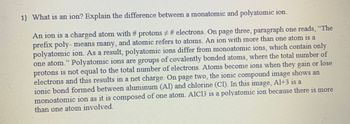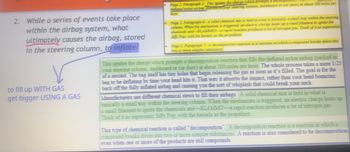
Chemistry
10th Edition
ISBN: 9781305957404
Author: Steven S. Zumdahl, Susan A. Zumdahl, Donald J. DeCoste
Publisher: Cengage Learning
expand_more
expand_more
format_list_bulleted
Question
thumb_up100%
The ion question is an example. You are not answering that question. It's just an example of how your answer should look for the other question.
Use evidence from the text and try to be detailed you can include prior knowledge you may know as well.

Transcribed Image Text:1) What is an ion? Explain the difference between a monatomic and polyatomic ion.
An ion is a charged atom with #protons # # electrons. On page three, paragraph one reads, "The
prefix poly- means many, and atomic refers to atoms. An ion with more than one atom is a
polyatomic ion. As a result, polyatomic ions differ from monoatomic ions, which contain only
one atom." Polyatomic ions are groups of covalently bonded atoms, where the total number of
protons is not equal to the total number of electrons. Atoms become ions when they gain or lose
electrons and this results in a net charge. On page two, the ionic compound image shows an
ionic bond formed between aluminum (Al) and chlorine (CI). In this image, Al+3 is a
monoatomic ion as it is composed of one atom. AIC13 is a polyatomic ion because there is more
than one atom involved.

Transcribed Image Text:2. While a series of events take place
within the airbag system, what
ultimately causes the airbag, stored
in the steering column, to inflate?
to fill up WITH GAS
get bigger USING A GAS
Page 2, Paragraph 2: This ignites the charge which prompts a
deflated nylon airbag (pack or your steering column, dashboard or car door) at about 200 miles par
Page 2, Paragraph 6: A solid chemical mix is held in what is basically a small tray within the steering
column. Then the mechanism is triggered an electric charge heats up a small filament to ignite the
chemicals and BLAMMO-a rapid reaction produces a lot of nitrogen gas. Think of it as supersonic
Jiffy Pop, with the kernels as the propellant.
Page 2 Paragraph 7: A decomposition reaction is a reaction in which a compound breaks down into
er substances
This ignites the charge which prompts a decomposition reaction that fills the deflated nylon airbag (packed in
your steering column, dashboard or car door) at about 200 miles per hour. The whole process takes a mere 1/25
of a second. The bag itself has tiny holes that begin releasing the gas as soon as it's filled. The goal is for the
bag to be deflating by time your head hits it. That way it absorbs the impact, rather than your head bouncing
back off the fully inflated airbag and causing you the sort of whiplash that could break your neck.
Manufacturers use different chemical stews to fill their airbags. A solid chemical mix is held in what is
basically a small tray within the steering column. When the mechanism is triggered, an electric charge heats up
a small filament to ignite the chemicals and BLAMMO!-a rapid reaction produces a lot of nitrogen gas.
Think of it as supersonic Jiffy Pop, with the kernels as the propellant.
This type of chemical reaction is called "decomposition". A decomposition reaction is a reaction in which a
compound breaks down into two or more simpler substances. A reaction is also considered to be decomposition
even when one or more of the products are still compounds.
Expert Solution
This question has been solved!
Explore an expertly crafted, step-by-step solution for a thorough understanding of key concepts.
This is a popular solution
Trending nowThis is a popular solution!
Step by stepSolved in 3 steps

Knowledge Booster
Learn more about
Need a deep-dive on the concept behind this application? Look no further. Learn more about this topic, chemistry and related others by exploring similar questions and additional content below.Similar questions
- Chrome File Edit View History Bookmarks Profiles Tab Window Help Purple/Black Iridescent - KPM X wilmington postal code - Goo X 9 Dealers - Niche W A www-awu.aleks.com/alekscgi/x/lsl.exe/1o_u-IgNslkr7j8P3jH-IvdWKW_BBZZI6tTytly O ATOMS, IONS AND MOLECULES Counting protons and electrons in atoms and atomic ions Fill in the missing information: atom or ion? check all that apply symbol number of number of protons electrons O neutral atom O cation O anion 12 10 V neutral atom O cation O anion 48 Ge O neutral atom O cation M anion Explanation Check IIarrow_forwardQuiz time Write your answers on your blank page and be prepared to upload a photo to this Quiz Assignment. 1. a. Write the Electron Configuration for Phosphorus b. Draw the Orbital Diagram for Phosphorus c. In your own words, and referencing to the Electron Configuration & Orbital Diagram for Phosphorus, describe how you used the Aufbau Principle, Hund's Rule and the Pauli Exclusion Principle. Include enough detail that would help to explain these concepts to someone for the first time. Take a picture of your work and upload to this form. * 1 Add file Send me a cony of my responsesarrow_forward1) Bohr stated that different elements gave off different colors that could explain the empty space in the atom. What do we call the colors given off by each atom? 2) Bohr described the atom as a multi-story building and said that the elements could only live on the floors and not in-between. He said that sometimes they jumped from one floor down to a lower floor. Describe what happens when these jumps occur. 3) What did the color of the spectra emitted by an element determine? 4) What is the difference between the ground state and the excited state of an electron?arrow_forward
- Charge imbalance on the atomic scale. a) If you come across a lone neon atom, is it likely to have an equal number of protons and electrons? Explain your answer. b) If you find yourself a lone iodine atom, is it likely to have an equal number of protons and electrons? Explain your answer.arrow_forwardCompare and contrast the contributions of J. J. Thomson, Ernest Rutherford, and Neils Bohr in a Venn diagram. Remember that the overlapping sections of thecircle are for similarities and the non-overlapping sections are for differences. Use all the words in the word box and their experimental conclusions.arrow_forwardTry Again Your answer is incorrect. • Left table: Your answer is incorrect. •Right table: Two of your answers are incorrect. Two sets of ionizations are shown in the tables below. Complete the tables by ordering each set of ionizations by increasing amount of energy required. In other words, for each set choose "1" next to the ionization that would require the least energy, "2" next to the ionization that would require the next least energy, and so on. ionization + Ne Ne + e + Cs → Cs + e + Rb Rb + e energy required 1 (least) î 2 3 (most) ↑ ionization + Ne Ne + e + Si Si te + Cs Cs + e X energy required 1 (least) 2 3 (most) S ↑ ↑ ↑arrow_forward
- MEA Naming components of the scientific method In the table below you will find three descriptions of sclentists engaging in activities that are part of the sclentific method. What are the missing words? description missing word? 5 ? After studying the chemical reactions of many compounds made of carbon, August discovers a chemical bonds to other atoms when it forms a compound. that says carbon always forms 4 about the arrangement of elements in the Wolfgang develops a Periodic Table, based on some ideas about how electrons are arranged in the different atoms of different elements. Using equations he develops, he is able to predict the exact arrangement of electrons in many atoms, and from there predict why they are where they are in the Periodic Table. Antoine burns some charcoal, and a very small diamond (!), and makes that the only product of both reactions is a heavy gas the (carbon dioxide). Explanation Check 2021 McGraw Hill LLC. All Rights Reserved. Terms of Use | Privacy C…arrow_forwardSolve correctly please.arrow_forwardCan you help with 17 and I showed you an answer from the answer book. I think the legend of the colors of the species might be incorrect. Does this make sense. ?This is not a graded question as it is a practice question . I am 60 years old and helping my son prepare for the AP exam in a few months. We do questions at the back of the textbook by Zumdahl and Zumdahlarrow_forward
arrow_back_ios
SEE MORE QUESTIONS
arrow_forward_ios
Recommended textbooks for you
 ChemistryChemistryISBN:9781305957404Author:Steven S. Zumdahl, Susan A. Zumdahl, Donald J. DeCostePublisher:Cengage Learning
ChemistryChemistryISBN:9781305957404Author:Steven S. Zumdahl, Susan A. Zumdahl, Donald J. DeCostePublisher:Cengage Learning ChemistryChemistryISBN:9781259911156Author:Raymond Chang Dr., Jason Overby ProfessorPublisher:McGraw-Hill Education
ChemistryChemistryISBN:9781259911156Author:Raymond Chang Dr., Jason Overby ProfessorPublisher:McGraw-Hill Education Principles of Instrumental AnalysisChemistryISBN:9781305577213Author:Douglas A. Skoog, F. James Holler, Stanley R. CrouchPublisher:Cengage Learning
Principles of Instrumental AnalysisChemistryISBN:9781305577213Author:Douglas A. Skoog, F. James Holler, Stanley R. CrouchPublisher:Cengage Learning Organic ChemistryChemistryISBN:9780078021558Author:Janice Gorzynski Smith Dr.Publisher:McGraw-Hill Education
Organic ChemistryChemistryISBN:9780078021558Author:Janice Gorzynski Smith Dr.Publisher:McGraw-Hill Education Chemistry: Principles and ReactionsChemistryISBN:9781305079373Author:William L. Masterton, Cecile N. HurleyPublisher:Cengage Learning
Chemistry: Principles and ReactionsChemistryISBN:9781305079373Author:William L. Masterton, Cecile N. HurleyPublisher:Cengage Learning Elementary Principles of Chemical Processes, Bind...ChemistryISBN:9781118431221Author:Richard M. Felder, Ronald W. Rousseau, Lisa G. BullardPublisher:WILEY
Elementary Principles of Chemical Processes, Bind...ChemistryISBN:9781118431221Author:Richard M. Felder, Ronald W. Rousseau, Lisa G. BullardPublisher:WILEY

Chemistry
Chemistry
ISBN:9781305957404
Author:Steven S. Zumdahl, Susan A. Zumdahl, Donald J. DeCoste
Publisher:Cengage Learning

Chemistry
Chemistry
ISBN:9781259911156
Author:Raymond Chang Dr., Jason Overby Professor
Publisher:McGraw-Hill Education

Principles of Instrumental Analysis
Chemistry
ISBN:9781305577213
Author:Douglas A. Skoog, F. James Holler, Stanley R. Crouch
Publisher:Cengage Learning

Organic Chemistry
Chemistry
ISBN:9780078021558
Author:Janice Gorzynski Smith Dr.
Publisher:McGraw-Hill Education

Chemistry: Principles and Reactions
Chemistry
ISBN:9781305079373
Author:William L. Masterton, Cecile N. Hurley
Publisher:Cengage Learning

Elementary Principles of Chemical Processes, Bind...
Chemistry
ISBN:9781118431221
Author:Richard M. Felder, Ronald W. Rousseau, Lisa G. Bullard
Publisher:WILEY